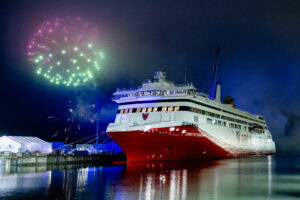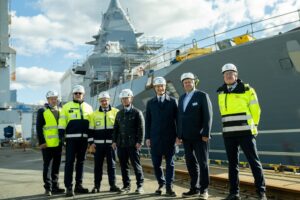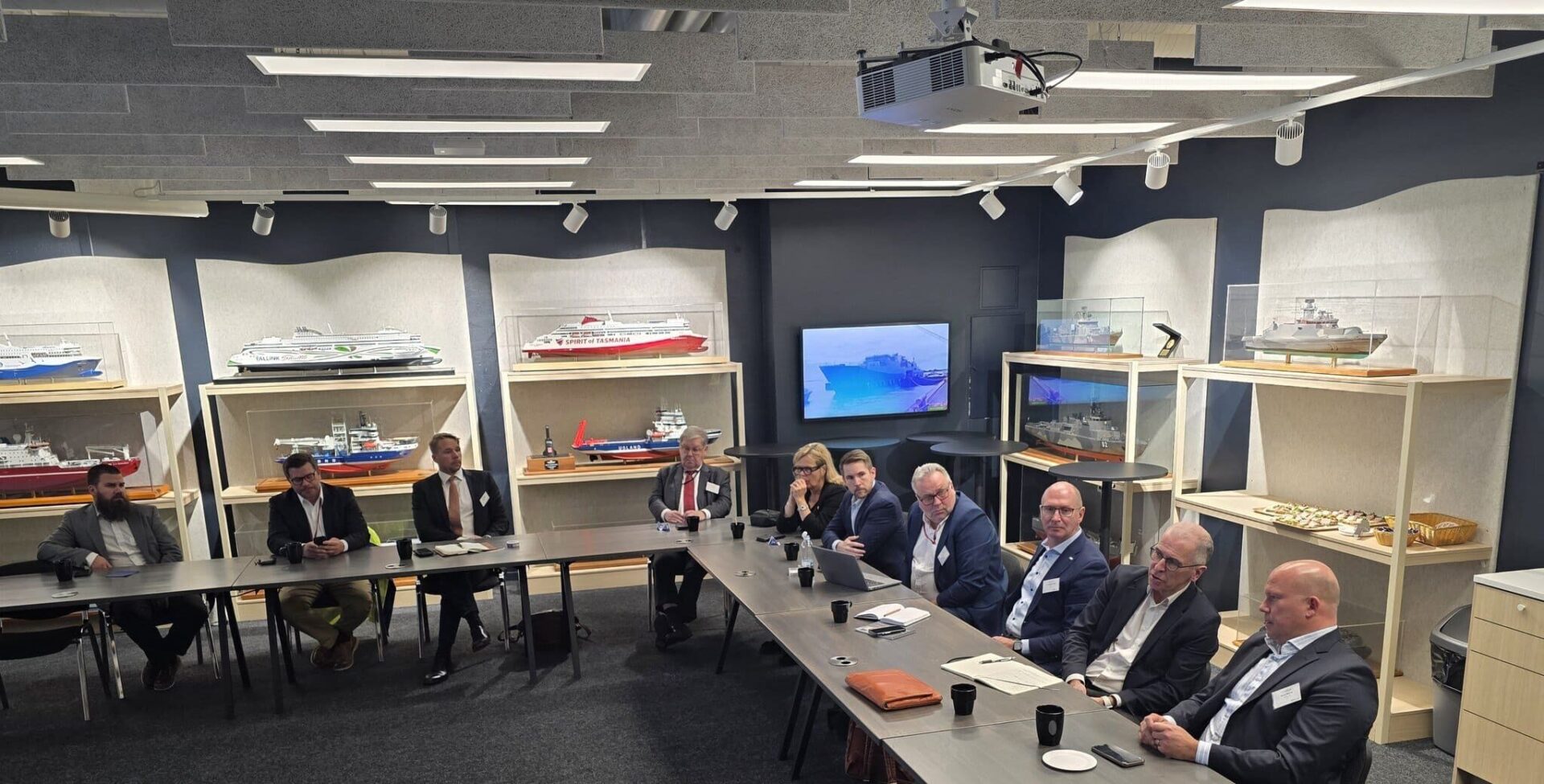EU Regulations expedite the decarbonisation of shipping and the electrification of ships, and the benefits of this are not reaped only by the environment, but also affect the operational costs of shipping companies significantly. Apart from building electric vessels, Rauma Marine Constructions (RMC) is also developing an approach where the investments of shipping companies in electric ships are subsidised through the new “energy as a service” business model. The electrification of maritime transport was the subject of a lively discussion attended by shipping companies at a roundtable organised by RMC this week.
For several years, ever since the goal of the decarbonisation of shipping by the year 2050 was adopted at the Glasgow Climate Change Conference in 2021, RMC together with its cooperation partners has been developing concepts for zero-emission shipping. The Decatrip project carried out in 2022–24 aimed at developing one of the world’s first green shipping corridors between Turku in Finland and Stockholm in Sweden. The FUSE project launched in 2023, on the other hand, focused on studying the concept of fully electric ships.
– An electric ship is technically possible in itself, but the bottleneck is charging. It needs to be charged after every voyage, says Mika Laurilehto, who is the CTO and Deputy CEO for RMC.
RMC’s experience in the building of an electric ship comes from the Aurora Botnia passenger ferry which is in service between Vaasa in Finland and Umeå in Sweden. This battery hybrid vessel received in 2021 the prestigious Ropax Ferry of the Year Award and in 2022 the Shippax Award for merits related to design and technology.
Electric ships give shipping companies a competitive edge
Until now, the technologies designed to reduce emissions have been expensive investments for shipping companies and caused operational difficulties. The transition to electric ships will bring emissions to zero and reduce the operating costs of ships. As the emissions trading system is reformed, new possibilities to generate revenue will open up to shipping companies operating with electric ships.
– Until now, shipping companies have paid emission penalties or procured renewable fuels. Now, shipping companies can purchase an electric ship which generates more revenue through emissions trading. This is a whole new opportunity. It will no longer come down to choosing between two poor alternatives, but they can select a good alternative that gives them a competitive edge, says Magnus Gustafsson, who is the Head of Research at the Åbo Akademi University.
RMC and Åbo Akademi work closely together in the electrification of shipping. According to Gustafsson, progress is rapid and the development of battery technology plays a key role. Batteries are becoming smaller and lighter as well as less expensive, and at the same time more powerful. The reduced size of batteries gives shipping lines yet another revenue possibility: the smaller batteries leave more space to carry freight.
Gustafsson says that the electrification of shipping means a huge change also for ship design and Finnish universities are increasing cooperation in this respect.
– New discoveries emerge all the time, he confirms.
Electric ships meet the requirements of the green transition
At the roundtable organised by RMC, the benefits of electrified maritime transport were seen as obvious.
Viking Line’s CEO, Jan Hanses, referred to the Helios concept, which has been developed by Viking Line, RMC and a few other partners. If implemented, it would be the world’s largest electric passenger-car ferry.
– The Helios-project heralds a new era in maritime transport, just like the first sail, steam, and motor ships did in their time. The concept proves that large-scale emission-free maritime transport is no longer a utopia. The world’s largest fully electric passenger-car ferries could be in operation as early as the beginning of the next decade. We are strongly committed to realizing the ambitious vision that Helios represents, says Viking Line’s CEO Jan Hanses.
Tallink Grupp is also interested in the potential of electric ships. Work towards the green transition is ongoing, including the introduction of new ships. The latest of these is the MyStar, which was built in Rauma.
– Tallink Grupp is in step with all requirements concerning a reasonable green transition and sustainable management in general. We have reduced CO₂ emissions across our entire fleet by an impressive 62% compared to 2008. New, more efficient ships have played a major role in this achievement, particularly the shuttle ships operating on the Tallinn–Helsinki route. The newest of these, the MyStar, was built at the Rauma shipyard. We are looking confidently to the future, constantly seeking opportunities to implement new environmentally friendly solutions and working to continuously improve the efficiency of our existing ships, says CEO HT Shipmanagement’s Tarvi-Carlos Tuulik.
“Energy as a service” model releases capital for shipping lines and ports
In addition to building electric ships, RMC has developed a business model which relieves shipping companies from having to tie large sums of money in batteries or in charging infrastructure in ports. This would solve one of the current bottlenecks – the challenge that ports are facing to invest in charging infra.
RMC is suggesting that business activities related to the life-cycle services provided to ships and ship maintenance could be expanded to cover also batteries and charging.
– The life-cycle services concept could be expanded to cover also, for example, battery rental, condition management, charging planning, and battery replacement planning. Software development for energy management would be included in this in a stronger role, explains Mari Hovi, who is the Head of the Machinery Areas Outfitting Department for RMC.
She says that an electric ship could even be sold without the batteries which would then be installed after delivery according to the “energy as a service” model.
– The investment in the ship would also be less expensive for the shipping company in this case, Mari Hovi points out.
Factory production of electric ships meets market potential of tens of billions
Teemu Kyläkallio, the Head of the R&D Department at RMC, tells that the electric ship technology available at present is suitable to all intra-European shipping by sea and inland waterways. In other ways, to about half of the total shipping volume. The rapid development of battery technology may open up possibilities for use also in inter-continental shipping.
The market is huge for car and passenger ferries and short-distance coastal vessels alone. Depending on the calculation method, a market potential of up to one hundred billion is possible initially.
RMC has already made preparations for wide-scale building of electric ships. The head start they have over others is significant: RMC has for several years researched, sought partnerships, and demonstrated their electric ship capabilities to clients. Over the next years, the potential will be so significant that demand must be met with new solutions. RMC has during the 2020s, in particular, achieved total competence and production chain management which the company wishes to take to a new level in producing factory-built electric ships.
– More effective production capacity is needed, meaning industrial production is the only alternative. We are redesigning the production processes so as to allow the ship to be completed to launching stage at the factory. The hull is assembled and outfitted ready for launching. An industrial factory process will reduce delivery times by a third and provide for competitive pricing, Mari Hovi explains.
Cooperation partners and equipment system manufacturers are interested in this development. The production process of electric ships will offer significant potential for growth also to these operators.
At the event, RMC’s CEO Mika Nieminen summarised the benefits of electric ships to shipping companies: lower investment and operating costs, improved risk management – and most of all, complete decarbonisation with emission-free ships.
Similar content




